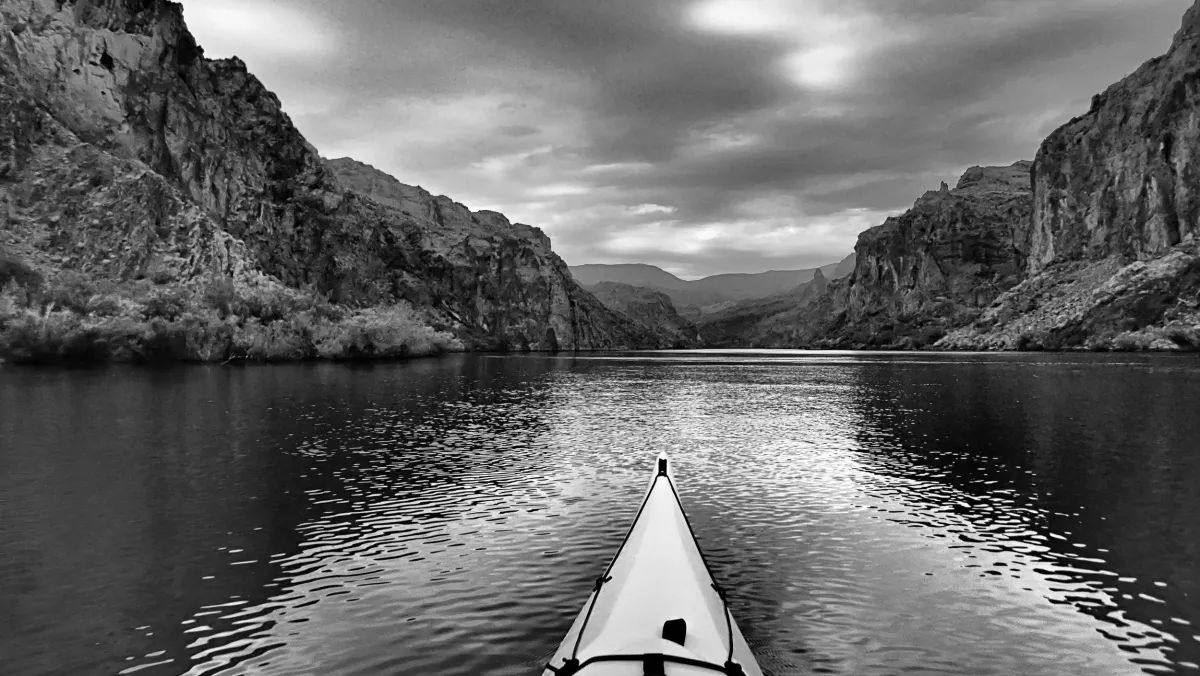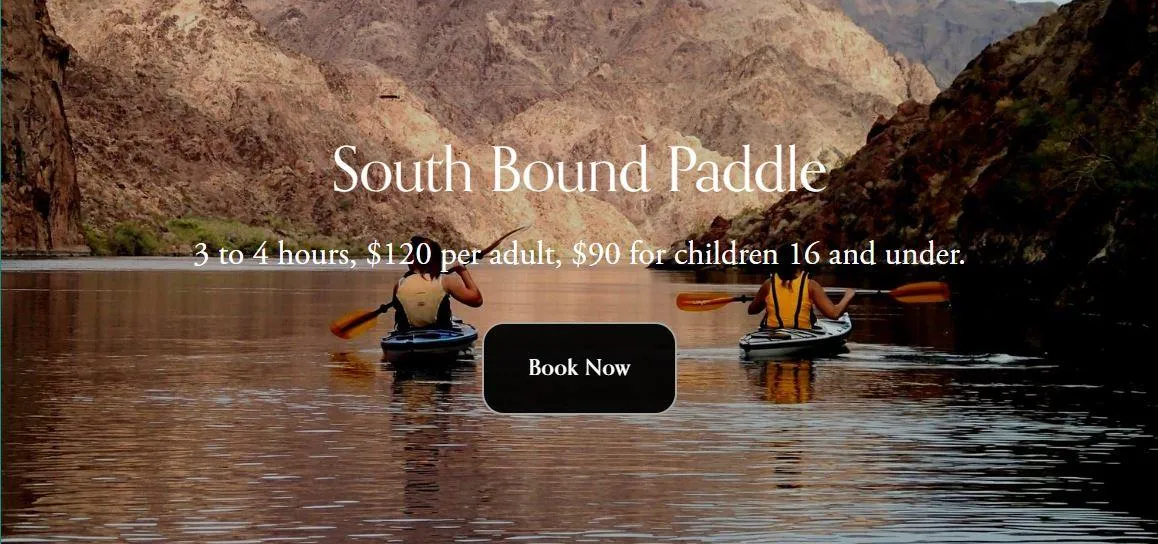How to kayak at night

There are two reasons to kayak at night. One is because you need to. The other is because you want to.
Reasons you NEED to kayak at night:
You are not yet at your destination and it is already lights out.
An emergency requires that you continue paddling in the dark to get help.
You are a kayak ninja.
Your adventure race team has opted to continue kayaking through the night.
Reasons you WANT to kayak at night:
It is summer time, you live in the desert like I do and since you want to go kayaking and don't necessarily want to paddle in 120 degree heat during the daylight hours; you learn to paddle at night.
You love paddling at night for all the reasons you love to paddle in the first place.
You're going on a moonlight paddle trip with us. PLUS, a nighttime paddle adds the element of surrealism to your hobby that is pure fantasy.
Lighting - to be seen:
If you are kayaking at night, you are navigating a vessel. You, the master of your craft, DO NOT want collisions to occur. Make sure you can be seen, PLUS, it is a Coast Guard requirement that...
"A vessel under oars may display those lights prescribed for sailing vessels or have ready at hand an electric torch or lighted lantern showing a white light which shall be exhibited in sufficient time to prevent collision. "
As master of my craft I want to adhere to the above mentioned requirement and I want to...
Display one white light with 1 mile minimum with 360 degree visibility!
1) As a minimum use green / yellow and red chem light glow sticks.
Attach them to the bow and stern and maybe one on the back of your PFD.
Don't put the green or yellow glow stick on the bow however, the light will interfere with your vision. Red on the bow won't bother your eyes.
Keep some glow sticks in your dry bag of emergency gear, along with some zip ties.
However, glow sticks will not make you legal.
In my opinion, the yellow or green glow stick is close enough to being a white light.
However, a glow stick(s) on your kayak will not be very visible for any useful distance and certainly not for a mile. And in the twilight they are hardly visible at all. But for emergencies they have a use.
2) The best lighting system for a kayak at night that I have found is The Guardian.
It is a small 360 degree, LED, lithium battery powered (included), waterproof, clip-on little guy that is the bomb for being seen at night.
Placed on your deck it easily gives you 1 mile visibility, but not 360 degrees. Place on your headlamp strap it gives you about 2 miles of 360 degree visibility.
AND it does not interfere with your night vision.
3) Wear your headlamp, you don't need to have it on all the time.
Waterproof would seem most advisable to kayakers, yet I have found that any good water resistant headlamp works fine and works for years.
If you wear a headlamp, (a) it gives you a place to clip on the guardian light, and (b) it allows you to shine a here I am directional light to nearby powered boaters thus, hopefully preventing a collision.
4) I wear my emergency strobe light in a pocket of my PFD.
This allows me to signal oncoming powered boaters in a last ditch effort to get their attention.
This is not the proper use of an emergency strobe light and so should be used sparingly, but I would say avoiding a collision justifies its use.
Lighting - to see:
1) Ambient light is always nice, you know, like a full moon.
2) Wearing your headlamp allows you to (a) see your chart(s), and (b) having a light with a strong focused beam is a great help during beach landings.
The ultimate headlamp provides area lighting for tasks, fairly good focused light for reading charts, and a really strong beam of light for spotting good landing spots on the beach.
Some headlamps do provide all three things, but are usually sort of heavy and or have too many functions.
Too many functions are like too many moving parts, something is bound to break.
3) A waterproof flashlight with a strong focused beam attached to your front deck is
(a) a back up to your headlamp and (b) will provide the really neat ability to view the beach of your intended landing.
4) Have a small backup headlamp or flash light in a zip-lock in your emergency gear dry bag.
Note: By the way, do not kayak at night without your emergency gear dry bag.
Seeing Others:
Powered boats will have lights (most of the time). A white light positioned high (for visibility), a green light on their right side, and a red light on their left side. The positioning of the green and red lights tells you at a glance important things about that powered boat.
If you see a green and red light - and the red light is on the left the powered craft is going away from you.
If you see a green and red light - and the red light is on the right the powered craft is coming towards you.
Night Vision:
1) Your best night vision is about 5 to 20 degrees off-center; from normal direct viewing.
This is because the retina, sometimes called purple retina, but I call cat retina, in your eyes that best translate low level light into nerve impulses are on the edges of your pupils.
When not using an artificial light, learn to view an object at night by looking 5 to 20 degrees away from it.
2) Artificial light will over charge your purple retina and temporarily ruin your night vision.
So, keep your headlamp off while paddling, besides the reflective light off of the paddle and the forward deck is very distracting.
3) Even the low level ambient light will over charge your purple retina after about only a second or two. Learn to view an object at night by not only looking slightly away from it,
but by also constantly moving your head and changing the angle of viewing.
This will engage fresh purple retina, keeping your night vision sharp.
4) Judging distance at night, or in other low visibility conditions like mist, is at times tricky.
Low level ambient light will make objects appear further away.
So, while navigating at night, trust your compass and watch, and not your faulty night vision.
5) Judging distances at night is an important aspect of night navigation.
Judging the distance of a fixed light at night is very tricky, so let's use that for an example...
Since it is impossible to tell whether a light is 10 yards away or several miles,
here is a technique to judge its distance: Intuitively use the technique of triangulation.
Put one finger tip just under the light. Close one eye. Tilt your head left and right.
Do not move the finger tip, leave it in a fixed position in relation to the light.
If the light is close it will not appear to move very much.
The further away it is, the more it will appear to move.
With practice you will be able to judge distances at night.
Feeling Winds and Waves:
Novice night paddlers sometimes get a little nervous in the wind driven waves.
This is understandable.
But having a knowledge of the dynamics of winds and waves will help to ally this a little.
Please read my article, High Winds.
Unless it is absolutely pitch black, you can use your night vision to judge the action of the waves.
Just as when applying the principle of not looking directly at an object,
allow your peripheral vision to see the waves.
If there is ambient light the tops of the waves will be lit up and the valleys will be dark.
If you try to look directly at the wave (the one that is concerning you),
you will misjudge its size, speed and position.
Of particular concern is kayaking at night in cross winds and with the wind:
1) At night when paddling transverse to the waves (cross wind) feel the waves as hills.
If you are on the side of any hill you need to balance so you won't tip and roll off.
Guard against rolling sideways off the hills of the waves by giving a little extra attention to both edging and leaning. Edge and or lean into the wave and plant your paddle into the wave's face.
This will prevent you from tipping / rolling sideways down and off the hill.
2) At night when paddling with the waves (down wind) feel the waves lift you from behind.
And just like in the daylight, paddle harder and try to match the wave's speed.
But, coming down the waves face, surfing, be a little more conservative.
As you broach, lean opposite the broach and apply your paddle as a rudder and be happy.
Slow down as the wave passes, no sense, just as in the day, of fighting the wave uphill.











